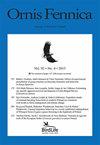The Mistle Thrush (Turdus viscivorus) in a production forestry context: A territory mapping study
IF 1.2
4区 生物学
Q2 ORNITHOLOGY
引用次数: 0
Abstract
In Northern Europe, the Mistle Thrush (Turdus viscivorus) is a relatively poorly studied species inhabiting forested landscapes where it has historically experienced population declines. Those declines have been attributed to the spread of intensive forest management; yet, the populations have stabilized or increased in recent decades. To distinguish the main forestry impacts on its breeding numbers and distribution, a multiple-visit territory-mapping study was carried out over 15 km2 of production forest landscape in Estonia. At the landscape scale, the breeding distribution was concentrated to conifer forests on bog peat where the densities were five times higher than in other conifer forests and (at least) ten times higher than in non-conifer forests. This reveals a broad distribution pattern where high-density (core) habitats only host a small fraction of the total population; their relative contribution to the recruitment remains unknown. At the breeding territory scale (within 150 m from a nest), Mistle Thrushes avoided recent clear-cuts and preferred larger areas of old stands more than expected from the distribution of suitable stands for nesting. This indicated that, in a short term, clear-cutting reduces nesting habitats of this species disproportionately more than expected from the cut area alone; this is in accordance with the documented 20th century declines of the species in Fennoscandia. The relationship with forestry drainage is more complicated, however, due to delayed effects and covariation with the main breeding habitat. The basic ecology of the species in conifer forest-wetland landscapes, which are subjected to management pressures, warrants future studies and might provide general insights into the dynamics and functioning of these ecosystems.生产林业背景下的雾画眉(Turdus viscivorus):一项领土测绘研究
在北欧,雾Thrush(Turdus viscivorus)是一种研究相对较少的物种,栖息在森林景观中,历史上它的种群数量一直在下降。这些下降归因于强化森林管理的蔓延;然而,近几十年来,人口已经稳定或增加。为了区分主要的林业对其繁殖数量和分布的影响,对爱沙尼亚15平方公里的生产森林景观进行了多次区域测绘研究。在景观尺度上,繁殖分布集中在沼泽泥炭上的针叶树林中,那里的密度是其他针叶树林的五倍,(至少)是非针叶树林密度的十倍。这揭示了一种广泛的分布模式,高密度(核心)栖息地只容纳总种群的一小部分;他们对招聘的相对贡献仍然未知。在繁殖区域范围内(距离巢穴150米以内),雾Thrushes避免了最近的砍伐,更喜欢更大面积的旧林分,而不是分布合适的林分进行筑巢。这表明,在短期内,明确的砍伐减少了该物种的筑巢栖息地,比仅从砍伐区域预期的要多;这与20世纪芬诺斯坎迪亚物种数量减少的记录一致。然而,由于延迟效应和与主要繁殖栖息地的协变量,与林业排水的关系更加复杂。针叶树森林湿地景观中物种的基本生态学受到管理压力,有必要进行未来的研究,并可能为这些生态系统的动态和功能提供一般见解。
本文章由计算机程序翻译,如有差异,请以英文原文为准。
求助全文
约1分钟内获得全文
求助全文
来源期刊

Ornis Fennica
生物-鸟类学
CiteScore
2.00
自引率
0.00%
发文量
14
审稿时长
>12 weeks
期刊介绍:
Ornis Fennica is a peer-reviewed international ornithological journal published by BirdLife Finland. Ornis Fennica publishes analytical and experimental papers on the ecology, behaviour and biogeography of birds. Ornis Fennica prefers studies concerning Fennoscandian species, but other novel contributions of general interest are most welcome as well.
Ornis Fennica is an open-access journal without page charges for publication. All published articles (from 1924 onwards) are freely available from the journal website. First decisions are usually made within three months of submission.
 求助内容:
求助内容: 应助结果提醒方式:
应助结果提醒方式:


